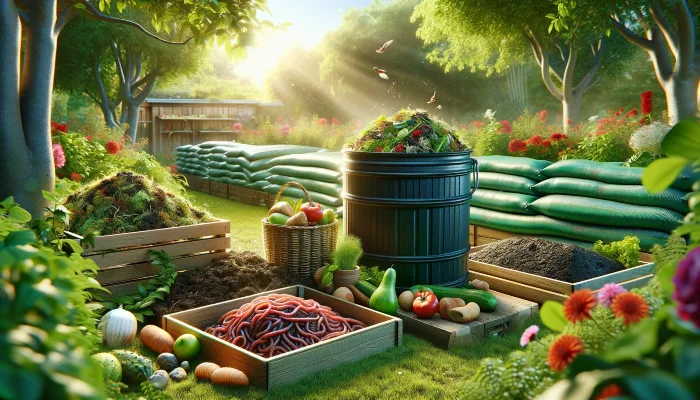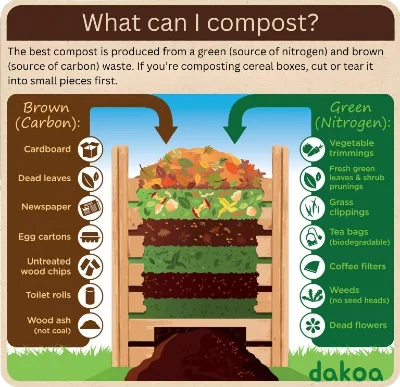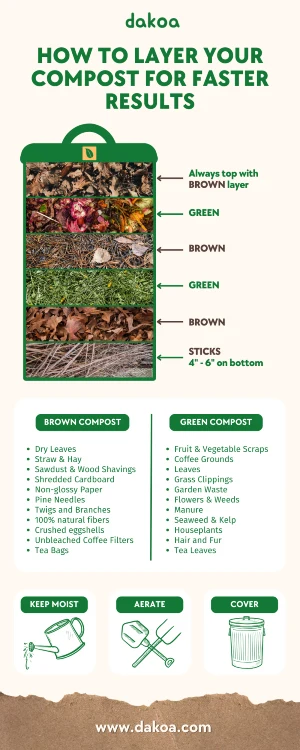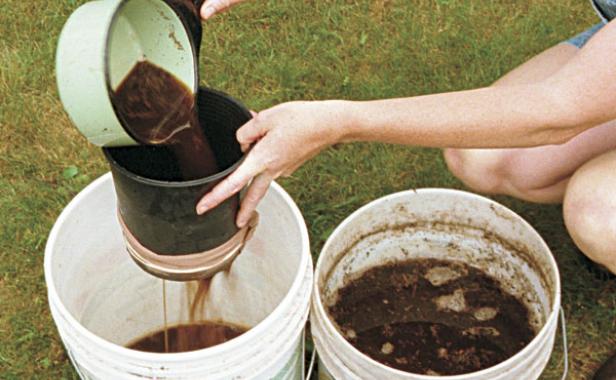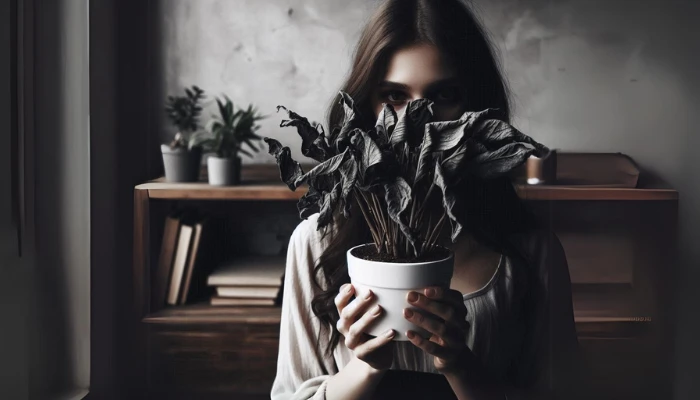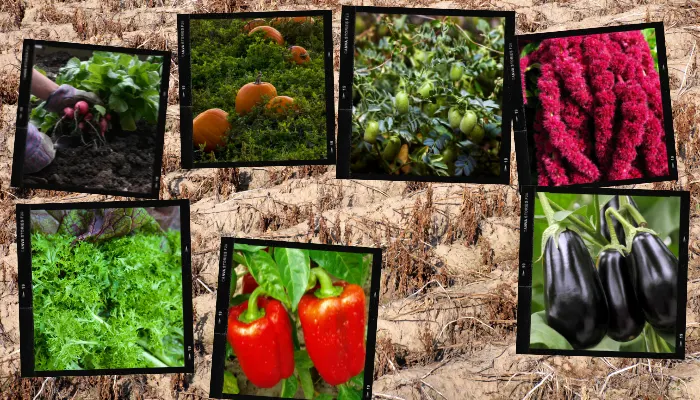Composting isn’t just about transforming kitchen scraps and yard waste into nutrient-rich soil, affectionately known as “black gold”, it’s a natural process that enriches the soil and cuts down on organic waste. It’s an eco-friendly powerhouse for gardeners and environmentally conscious individuals alike. Basically, composting is good for everyone!
The Basic Ingredients of Good Compost
At the heart of composting are two essential types of materials: green and brown. Green materials, such as food scraps and grass clippings, are rich in nitrogen, feeding the microorganisms that break down the waste.
On the other side, brown materials like dry leaves and wood chips provide carbon, balancing the compost pile and aiding in effective decomposition. Striking the right balance between these materials is crucial for creating good compost.
Key Components of Effective Composting
Creating good compost is both an art and a science, requiring attention to several critical factors that influence how organic materials transform into nutrient-rich soil. Understanding these components will help you manage your compost pile more effectively and yield the best results for your garden.
Feedstock and Nutrient Balance
The cornerstone of successful composting lies in the proper balance of “green” and “brown” materials, which provide nitrogen and carbon, respectively.
- Green materials include kitchen scraps, coffee grounds, grass clippings, and vegetable peelings—rich in nitrogen and essential for microbial growth.
- Brown materials, such as dry leaves, wood chips, cardboard and shredded newspaper, offer carbon, which fuels the microbes.
The ideal ratio of brown to green materials is often recommended as 3:1 by volume, but this can vary based on your specific composting conditions and materials.
Particle Size
The size of the compost materials can significantly affect the decomposition speed. Smaller particles provide a larger surface area for microbes to work on, accelerating the composting process. However, if the particles are too small, they can compact, leading to reduced airflow and slower decomposition. Chopping or shredding your green and brown materials to a uniform, medium size can help maintain a healthy composting environment. This ensures a more homogeneous compost mixture and optimizes insulation within the pile, which is crucial for maintaining the necessary microbial activity.
Moisture Content
Moisture is vital for the survival of the microorganisms that break down organic matter in the compost pile. The content should feel like a wrung-out sponge—moist but not dripping. If the compost is too dry, microbial activity slows down, stalling decomposition. If it’s too wet, it can lead to anaerobic conditions, creating unpleasant odors and potentially harming beneficial microorganisms. Regularly check the moisture levels and adjust by adding water or dry materials as needed to maintain the ideal moisture balance.
Oxygen Flow
Aerating the compost pile is crucial for maintaining an aerobic environment, where oxygen is available to support the microbes decomposing the organic material. Techniques for aerating your pile include turning it with a pitchfork or shovel, adding structured materials like wood chips or straw to create air pockets, or using a compost aeration tool. Adequate oxygen flow prevents the pile from becoming anaerobic, which can slow down the composting process and produce foul smells.
Temperature
The heat generated by microbial activity is a good indicator of a thriving compost pile.
That may sound overly technical and boring, but the microbial activity can raise the pile’s core temperature to between 135°F and 160°F, which helps to speed up decomposition, kill pathogens, and weed seeds. Granted, it’s not a pickle ball game, but from a natural sustainability perspective… it’s very exciting!
Monitoring the temperature with a compost thermometer can tell you when to turn the pile to redistribute heat and microbes throughout the pile, ensuring even decomposition. If the temperature is too low, it might indicate inadequate nitrogen, moisture, or aeration, whereas excessively high temperatures could indicate too much nitrogen or insufficient aeration.
By mastering these key components, you can enhance your composting process, making it more efficient and effective. This leads to the production of high-quality compost that can enrich soil and support plant growth, turning your garden waste into a valuable asset for your gardening endeavors.
Types of Composting Methods
Hot Composting
Hot composting is a fast-paced, temperature-driven method that requires maintaining a large pile at a high temperature. It’s perfect for those who wish to compost large quantities of organic matter, including food waste and yard trimmings, efficiently. The high temperatures speed up the composting process and kill weed seeds and pathogens, ensuring a clean and healthy result.
Cold Composting
For the patient gardener, cold composting is a more laid-back approach. It involves simply piling up yard waste, kitchen scraps, and other organic materials and letting nature do its thing. This method takes longer than hot composting, often up to a year, but it’s a great way to compost without much fuss (or work).
Specialized Composting Techniques
Vermicomposting
Vermicomposting uses red wigglers to turn organic waste into high-quality compost, ideal for enriching vegetable gardens. These worms consume food scraps and other organic materials, producing worm castings—another term for worm poop—that gardeners prize for its nutrient content. This type of composting is well-suited for indoor environments, making it a fantastic option for apartment dwellers. So if you’ve ever wanted a worm bin, this is your chance!
Aerated (Turned) Windrow Composting
This large-scale composting method involves forming organic waste into long rows called windrows. These are periodically turned to introduce oxygen, which speeds up the composting process. Windrow composting is suited for community operations or large gardens with plenty of space to manage the piles.
Aerated Static Pile Composting
Aerated static pile composting is designed for rapid compost production, using layers of loosely piled bulking agents like wood chips to enhance airflow. It’s a method that supports high-volume compost makers, such as landscapers or local governments, dealing with community yard waste and food scraps.
In-Vessel Composting
In-vessel composting offers the most control over environmental conditions like temperature and moisture. This method uses enclosed containers, where organic materials are mechanically turned. It’s suitable for virtually any type of organic waste, and is especially useful in settings where space is limited, or odor control is crucial.
Choosing the Right Compost Method for Your Needs
Selecting the right type of compost method depends on your specific circumstances. Consider the amount of space you have, the types of organic materials you need to compost, and how quickly you need the compost to be ready. Each method offers different benefits, whether it’s the speed of hot composting or the simplicity of vermicomposting.
Composting Challenges and Tips
To achieve the best results, manage moisture levels and avoid creating anaerobic conditions that slow down the composting process and produce unpleasant odors. Also, remember to chop or shred large pieces of organic waste to speed up decomposition and ensure a more homogeneous compost mixture.
Benefits of Making Your Own Compost
By composting at home, you not only produce valuable compost for your garden, but also significantly reduce your environmental footprint by minimizing organic waste. This practice can reduce reliance on chemical fertilizers, which provides a more natural growth environment for your plants. And, of course, there’s always the compost tea!
Questions About Composting?
What’s the most popular type of composting?
Hands-down cold composting. Sure, it takes up to a year to fully work, but it’s easy, requires very little effort and if you forget about your compost pile, it’ll be okay. Although the odor usually reminds people.
What are the different types of compost systems?
Composting can be adapted to various settings and needs, ranging from simple home composting in a backyard bin to complex commercial composting facilities that handle large volumes of organic waste. Popular systems include static piles, which are low-maintenance but slow, and turned piles or rows, which require more effort but decompose quicker.
Can I use worm bins for composting in my apartment?
Absolutely! Worm bins, or vermicomposting systems, are perfect for indoor use, making them ideal for apartment dwellers. They use red worms to break down kitchen waste into worm castings or “worm tea,” which are excellent for garden beds and houseplants.
What should I consider when choosing a type of compost bin?
Selecting the right type of compost bin depends on the amount of space you have, the type of organic material you plan to compost, and how actively you want to manage the composting process. Options range from open piles to tumbler systems, aerated static piles, and enclosed bins.
How does anaerobic composting differ from aerobic composting?
Anaerobic composting happens without oxygen, typically in sealed conditions. It’s slower than aerobic composting and can sometimes produce a strong odor. However, it requires less physical labor since it does not need turning.
Is it possible to compost dairy products and other animal products?
Composting animal products, including dairy like yogurt, is possible as long as you manage it carefully, ideally in a high-temperature system or a biodigester.
How long does it take to produce finished compost?
The time it takes to produce compost can vary widely depending on the method used. Cold composting can take a year or longer, while hot composting can produce finished compost in as little as three months if conditions are ideal.
What materials are considered compostable?
Compostable materials include all plant materials, some paper products, and certain food scraps. Avoid composting treated wood, colored paper, and plastic-labeled biodegradable without certification for compostability. But, you can compost cereal boxes.
What is multipurpose compost?
Multipurpose compost is commercially prepared to be suitable for a wide range of planting needs. It typically includes peat moss or peat-free alternatives, fertilizers, and wetting agents so it can support plant growth in various conditions.
How do I maintain proper moisture and temperature levels in my compost pile?
Maintaining moisture involves keeping the compost as wet as a wrung-out sponge. During dry weather, add water to the pile as needed. For temperature, aim for a range of 135°F to 160°F to efficiently break down materials and kill pathogens. Monitor with a compost thermometer and turn the pile if temperatures are uneven or too low.
Can I use peat moss in composting?
Peat moss can be used in composting to add bulk and improve moisture retention. However, it is acidic (suitable for ericaceous compost for acid-loving plants), and its sustainability as a resource is debated, so alternatives like coconut coir are often recommended.
What is the role of green manure in composting?
Green manure are plant materials left to rot in the soil. They enrich the soil by fixing nitrogen and adding organic matter, like adding similar materials to a compost pile.
Conclusion
Composting has options for different lifestyles and gardening needs. Whether you’re a city dweller with a small balcony or a large-scale gardener, composting can adapt. Start your compost pile today and watch as your garden transforms with the addition of rich, homemade compost.







